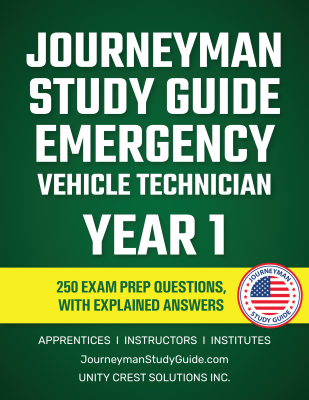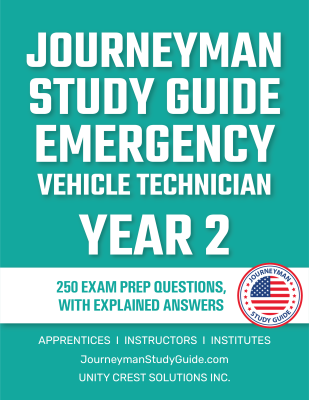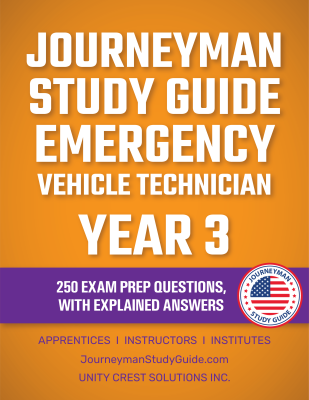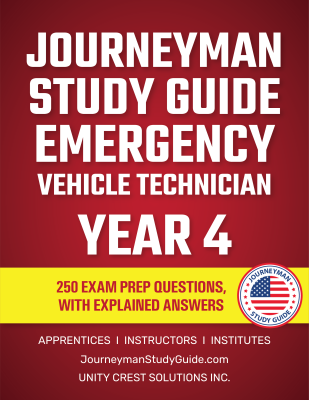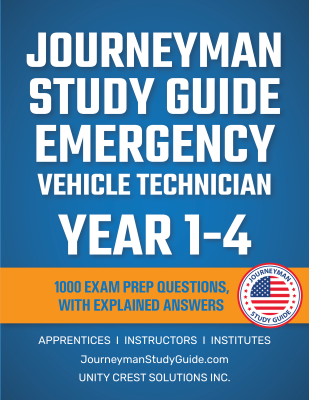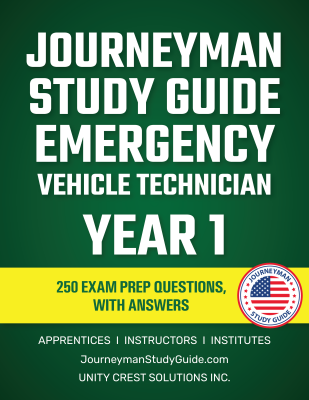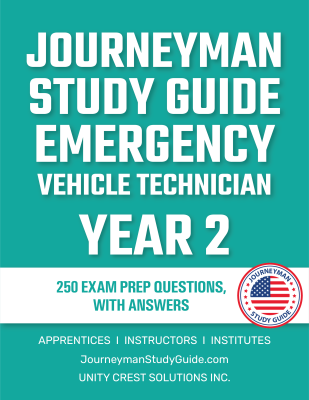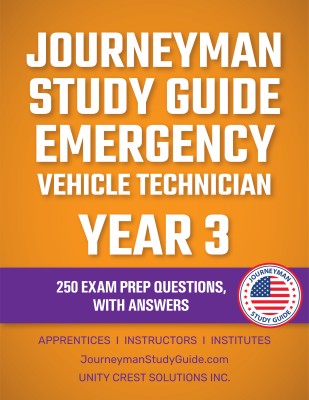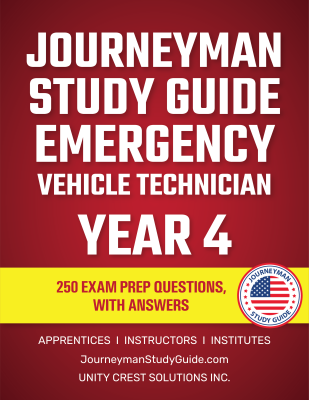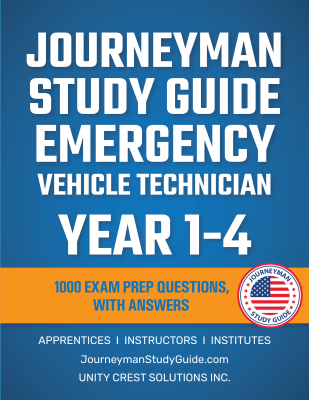Questions, Answers, & Explanations
Get clear explanations behind every answer, perfect for deeper learning and more thorough exam preparation.
Site Updates in Progress: Things might look different as we work on enhancing your experience.
Emergency Vehicle Technicians (EVTs) are highly trained professionals responsible for maintaining and repairing fire trucks, ambulances, police vehicles, and other emergency response units. Their expertise ensures that these life-saving vehicles operate reliably and efficiently, supporting first responders in their critical missions.
EVTs specialize in diagnosing and repairing complex electrical, mechanical, and hydraulic systems found in emergency vehicles. Their duties include:
Successful Emergency Vehicle Technicians need a mix of technical expertise, problem-solving ability, and attention to detail:
Emergency Vehicle Technicians are essential in multiple sectors, including:
Becoming an EVT offers job stability, competitive wages, and the opportunity to make a difference in public safety:
Becoming an EVT requires specialized training in vehicle diagnostics, electrical systems, and regulatory compliance. Our Q&A study guides, online tests, and certification prep materials help aspiring technicians prepare for EVT exams and licensing.
What to Expect on the Emergency Vehicle Technician Certification Exam
The Emergency Vehicle Technician (EVT) Certification Exam ensures that technicians meet U.S. industry standards for inspecting, diagnosing, and repairing emergency response vehicles. Many employers, fire departments, ambulance services, and municipal fleet operations require EVT certification to demonstrate expertise in maintaining fire trucks, ambulances, and law enforcement vehicles. Obtaining certification enhances career opportunities and ensures compliance with NFPA (National Fire Protection Association) and DOT (Department of Transportation) regulations.
Exam Format
The EVT exam assesses both theoretical knowledge and practical application of emergency vehicle maintenance. Here’s what you can expect:
Key Topics Covered
The exam is divided into sections that assess critical skills and knowledge areas:
Passing Requirements
Most certifying bodies require a minimum score of 70% or higher to pass the written exam. Some certifications may include a hands-on practical assessment, where technicians must demonstrate skills in vehicle inspection, component replacement, and electrical diagnostics.
Tips for Preparing Effectively
Ready to Pass Your Exam?
Prepare for certification with our expertly crafted study guides, detailed Q&A explanations, and interactive online tests tailored specifically for Emergency Vehicle Technicians.
What Types of Questions Are on the EVT Certification Exam?
The Emergency Vehicle Technician Certification Exam assesses knowledge of vehicle systems, safety protocols, and diagnostic procedures. The test includes a variety of question formats designed to evaluate real-world troubleshooting skills and regulatory compliance. Understanding these question types will help you prepare effectively and pass with confidence.
Common Question Formats
Sample Questions
1. Safety and Compliance
Question: "Which NFPA standard applies to the inspection, maintenance, and testing of in-service fire apparatus?"
2. Electrical and Communication Systems
Question: "What is the primary purpose of a relay in an emergency vehicle’s electrical system?"
3. Brakes and Suspension Systems
Question: "An ambulance with air brakes has a warning buzzer that activates at what air pressure level?"
4. Engine and Transmission Maintenance
Question: "Which engine manufacturer is commonly found in modern U.S. fire trucks?"
5. Hydraulics and Pneumatics
Question: "If a hydraulic rescue tool requires 5,000 PSI to operate but is only reaching 3,000 PSI, what is the most likely cause?"
Tips for Answering Exam Questions
Practice Questions for Better Preparation
Engaging with practice exams is one of the most effective ways to improve performance. Benefits include:
Our Q&A with Explanations helps you understand why answers are correct, while our Online Tests simulate real testing conditions with live scoring and feedback.
Want More Practice?
Access hundreds of practice questions, detailed explanations, and interactive tests tailored for Emergency Vehicle Technicians. Improve your confidence and ensure success on exam day.
What Is It Like to Work as an Emergency Vehicle Technician?
The daily life of an Emergency Vehicle Technician (EVT) is fast-paced and essential to public safety. EVTs work in municipal fleet services, private ambulance companies, and fire department maintenance shops, ensuring emergency vehicles remain in peak operational condition. Whether repairing fire trucks, ambulances, or police vehicles, their expertise ensures first responders can perform life-saving duties without mechanical failures.
Morning: Preparing for the Job
The workday starts early, typically around 7:00 AM, with planning and preparation:
Midday: Hands-On Repair and Diagnostics
Most of the day is spent conducting repairs and preventive maintenance on emergency vehicles:
Afternoon: Quality Control and Documentation
As the day wraps up, final inspections ensure all repairs meet industry standards:
Challenges and Rewards
✅ Challenges: Diagnosing complex electrical issues, working in high-pressure environments, and ensuring compliance with evolving regulations.
✅ Rewards: Competitive pay, job security, and the satisfaction of knowing their work helps save lives.
Ready to Start Your EVT Career?
Prepare for certification and career success with our study guides, Q&A products, and interactive online tests designed for Emergency Vehicle Technicians.
What Are the Long-Term Benefits of a Career as an Emergency Vehicle Technician?
A career as an Emergency Vehicle Technician (EVT) offers stability, strong wages, and opportunities for advancement. Skilled EVTs are in high demand as municipalities, fire departments, and ambulance services require certified professionals to maintain critical emergency fleets.
Earning Potential in EVT Careers
Salaries vary based on experience, certification, and region:
Regional Salary Differences
Career Growth Opportunities
The Benefits of Certification
✔ Competitive Edge – Certified EVTs earn higher salaries and have more job opportunities.
✔ Career Mobility – EVT certification allows technicians to work in government, private industry, or emergency fleet contracting.
✔ Job Security – The demand for skilled emergency vehicle technicians remains strong across the U.S.
Success Stories
🚒 Mike, Lead EVT for a Fire Department: After earning Level III EVT Certification, Mike became head of fleet maintenance for a large municipal fire department.
🚑 Jessica, EVT Instructor: Jessica transitioned from fleet repair to training new technicians at a technical college EVT program.
Why Choose an EVT Career?
✅ Strong Demand – Municipalities and private companies need skilled technicians.
✅ High Wages – EVT certifications increase earning potential.
✅ Career Advancement – Opportunities to move into management, teaching, or specialized repair fields.
Ready to Advance Your Career in EVT?
Prepare for certification and career success with our study guides, Q&A materials, and interactive online tests tailored for Emergency Vehicle Technicians.
How Much Can You Earn as an Emergency Vehicle Technician?
Salaries for Emergency Vehicle Technicians (EVTs) vary based on experience, certification level, and location. Whether working for municipal fleet services, private ambulance companies, or fire department maintenance shops, EVTs benefit from competitive wages and strong job security. Certified technicians often earn higher salaries due to specialized expertise in fire truck, ambulance, and police vehicle maintenance.
General Wage Ranges
Here’s a breakdown of typical earnings at different career stages:
Regional Salary Differences
Wages vary depending on location and demand:
Factors That Impact Wages
Want to Boost Your Earning Potential?
Advance your career with our study guides, Q&A products, and interactive online tests to improve your skills and increase your earning power.
What Tools and Resources Do Emergency Vehicle Technicians Need to Succeed?
Emergency Vehicle Technicians (EVTs) rely on specialized diagnostic tools, repair equipment, and industry resources to ensure emergency vehicles remain fully operational. Whether working in a fire department maintenance shop, municipal fleet garage, or private EMS repair facility, having the right tools and training is essential for success.
Essential Tools for EVTs
Recommended Learning Resources
Why the Right Tools Matter
✅ Efficiency – The right tools reduce diagnostic time and improve repair accuracy.
✅ Safety – Specialized safety equipment ensures compliance with NFPA and OSHA regulations.
✅ Career Advancement – Mastering industry tools and techniques leads to higher-paying opportunities.
Looking for the Best Study Materials?
Prepare for certification and career success with our study guides, Q&A products, and interactive online tests designed for Emergency Vehicle Technicians.
Where Can You Learn to Become an Emergency Vehicle Technician?
Training programs for Emergency Vehicle Technicians (EVTs) in the U.S. combine hands-on experience with classroom instruction, preparing students to maintain and repair fire trucks, ambulances, and law enforcement vehicles. Proper education ensures that EVTs develop expertise in diagnostics, electrical systems, hydraulic components, and emergency response vehicle safety standards.
Types of EVT Education Programs
What to Expect in an EVT Training Program
How to Choose the Right Program
Why Education Matters in the EVT Field
✅ Job Security – Certified EVTs are highly sought after by fire departments and private fleet services.
✅ Higher Wages – Formal training and certification lead to better salaries.
✅ Advancement Opportunities – Education allows for growth into supervisory and management positions.
Ready to Start Your EVT Career?
Get started with our study guides, certification resources, and interactive practice exams to become a top Emergency Vehicle Technician.
Why Join a Union or Connect with Employers?
Unions and reputable employers provide Emergency Vehicle Technicians (EVTs) with job security, competitive wages, and career advancement opportunities. Union membership offers specialized training, benefits, and workplace representation, while working with top employers ensures consistent employment and professional growth.
Benefits of Joining a Union
Top Unions for Emergency Vehicle Technicians
Connecting with Employers
Why Unions and Employers Matter in EVT Careers
✅ Secure Employment – Municipal and union jobs provide steady work and strong benefits.
✅ Higher Pay – Union-represented EVT positions offer better wages.
✅ Career Growth – Working with top employers leads to long-term career advancement.
Ready to Connect with the Best EVT Opportunities?
Explore our study guides, union resources, and employer connections to advance your Emergency Vehicle Technician career.
How to Stay Ahead in the Emergency Vehicle Technician Industry
The Emergency Vehicle Technician (EVT) field is evolving with advancements in vehicle technology, stricter safety regulations, and growing demand for fleet maintenance professionals. Staying competitive in the industry requires continuous learning, hands-on experience, and adapting to emerging trends.
Emerging Trends in Emergency Vehicle Maintenance
Best Practices for Professional Growth
Challenges and Opportunities in the EVT Field
✅ Challenges:
✅ Opportunities:
Why Staying Ahead Matters in the EVT Industry
🚒 Innovation and adaptability drive the emergency vehicle maintenance field.
🚑 Learning new technologies and staying compliant with regulations ensures career success.
🚓 Industry certifications and continuing education make EVTs more valuable to employers.
Stay Informed, Stay Competitive
Prepare for success with our specialized study guides, EVT certification materials, and industry resources designed for Emergency Vehicle Technicians.
Get clear explanations behind every answer, perfect for deeper learning and more thorough exam preparation.
Quick and easy practice to test your knowledge anytime, anywhere—ideal for simple, on-the-go preparation.

